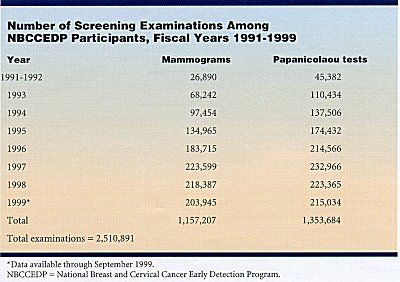CDC Program Provides 2.5 Million Cancer Tests Screenings Over First 9 years
WASHINGTON-More than 2.5 million mammograms and Papanicolaou tests were provided to women in the first 9 years of the National Breast and Cervical Cancer Early Detection Program (NBCCEDP), managed by the Centers for Disease Control and Prevention (CDC). The total includes 1,157,207 mammograms and 1,353,684 Pap tests administered from 1991 through September 1999.
WASHINGTONMore than 2.5 million mammograms and Papanicolaou tests were provided to women in the first 9 years of the National Breast and Cervical Cancer Early Detection Program (NBCCEDP), managed by the Centers for Disease Control and Prevention (CDC). The total includes 1,157,207 mammograms and 1,353,684 Pap tests administered from 1991 through September 1999.
NBCCEDP was created by the Breast and Cervical Cancer Mortality Prevention Act of 1990. Its purpose is to provide screening services to the under-served, including older and low-income women, and women from ethnic and minority groups. These services include a physical examination of the breasts, mammography, pelvic examination, and Pap test.
CDC now supports early detection programs for the two cancers in the 50 states, the District of Columbia, 6 US territories, and 12 American Indian and Alaska Native organizations. Through September 1999, NBCCEDP yielded more than 7,300 breast cancer and 600 cervical cancer diagnoses, as well as more than 37,000 precancerous cervical lesions.

White, non-Hispanic women received 52% and 53% of the mammograms and Pap tests, respectively. Among minority women, comparable numbers were: Hispanic, 20% and 20%; black, non-Hispanic, 17% and 15%; American Indian/Alaska Native, 6% and 7%; Asians, 3% and 3%; and women of other or unknown ethnic status, 2% each.
The number of mammograms in 1991-1992 was 26,890 and reached a peak of 223,599 in 1997. Pap tests numbered 45,382 in 1991-1992 and totaled 232,966 in 1997. In the first 9 months of 1999, 203,945 mammograms and 215,034 Pap tests were provided to women (see Table).
In addition to 27,000 participating health professionals and 18,000 health educators and outreach workers, NBCCEDP has a network of coalitions and partnerships with many private organizations that help to support it. One such partnership, Avon, has raised more than $37 million to educate women and provide access to early detection services through its Breast Cancer Awareness Crusade, CDC said in a fact sheet marking the 10th year of the program.